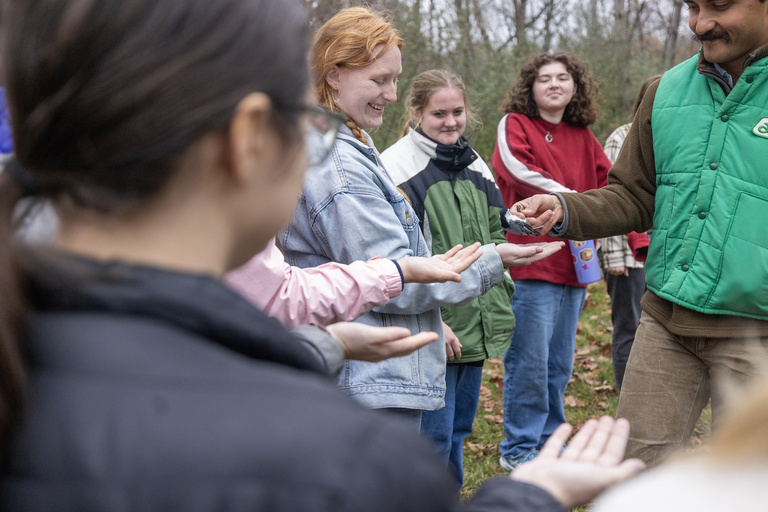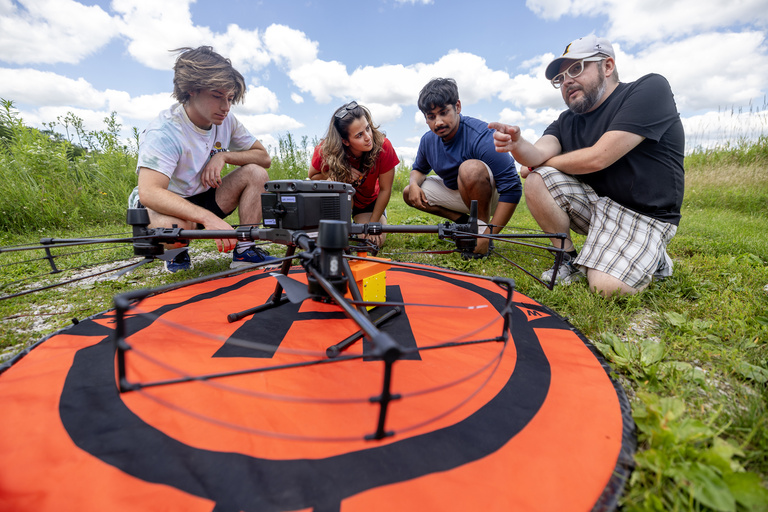As a student, Earth is your classroom! Many courses within the School of Earth, Environment, and Sustainability (SEES) have an outdoor component that allows you to apply your knowledge in the field, adding a “doing” element to your learning. We encourage you to seek out unique opportunities from field trips and data collection to labs and demonstrations as you determine next semester’s classes. Use the table below to discover courses that offer engaging outdoor experiences! *Counts towards the GE CLAS Core Sustainability requirement.
If using a mobile device, scroll to the right to see additional SEES degree programs.
Course | Earth and Environmental Sciences, BA, BS, Minor | Geographical and Sustainability Sciences, BA | Geographical and Sustainability Sciences, BS | Environmental Policy and Planning, BA, Minor | Sustainability Certificate |
| BIOL:2246 | Entomology Lab¹ |
| ||||
| *SEES:1035 | Our Digital Earth² |
|
|
| ||
| SEES:2001 | Second-Year Field Trip for Earth and Environmental Sciences |
| ||||
| SEES:2950 | Environmental Conservation |
|
|
|
| |
| SEES:3001 Third-Year Field Trip for Earth and Environmental Sciences |
| ||||
| SEES:3160 | Field Trip |
| ||||
| SEES:3230 | Prairie Restoration³ |
|
| |||
| SEES:3315 | Ecosystem Ecology |
|
| |||
| SEES:3330 | Sedimentary Geology |
| ||||
| SEES:3350 | Urban Ecology⁴ |
|
|
|
| |
| SEES:3360 | Soil Genesis and Geomorphology |
|
| |||
| SEES:3500 | Introduction to Environmental Remote Sensing⁵ |
|
|
| ||
| SEES:4001 | Fourth-Year Field Trip for Earth and Environmental Sciences |
| ||||
| SEES:4010 | Field Methods in Physical Geography |
|
|
| ||
| SEES:4500 | Advanced Remote Sensing⁶ |
|
|
| ||
| SEES:4600 | Biogeography, Ecology, and Conservation of Mammals⁷ |
|
| |||
| SEES:4630 | Hydrogeology |
|
| |||
| SEES:4832 | Geologic Field Analysis⁸ |
|
Notes about how some classes use the outdoors:
¹ 4-5 field trips to local natural areas, including MacBride Nature Recreation Area, Ashton Prairie Living Laboratory, and Clear Creek Area, to collect and study insects in the wild. Students learn about different ways to collect insects, study insect behavior, document taxonomic diversity, and generally try to spend time appreciating natural history and studying biology in nature. The course is taught in the Fall semester.
² Unpiloted aerial vehicle demonstration conducted at Ashton Prairie Living Laboratory. It is offered every Spring semester.
³ Outdoor classes and activities such as plant identification at Ashton Prairie Living Laboratory; field trip to local prairies to do restoration work.
⁴ Students spend the last part of the semester designing research projects. They work in teams to select and research a topic, design a project, and execute that project. Most students chose to do field projects and chose their field sites to match their topic. The course is taught in the Spring semesters of alternating years and will be offered in Spring 2026.
⁵ Unpiloted aerial vehicle demonstration conducted at Ashton Prairie Living Laboratory. It is offered every other Fall semester
⁶ Unpiloted aerial vehicle demonstration conducted at Ashton Prairie Living Laboratory and spectral measurement collection on campus. It is offered in the Fall semester in alternating years.
⁷ Field labs as well as a student-designed field project. Some labs occur on campus or in City Park. Labs take place in different parks in the Iowa City area, MacBride Nature Recreation Area, Clear Creek Greenway, and Hickory Hill. Students chose their field sites if the opt to do a field project. It is offered in the Spring semesters of alternating years and will be offered next in Spring 2027.
⁸ Three-week long summer course (late-May to early-June) in western Montana. Days are spent field mapping and learning the regional geology of the area.



